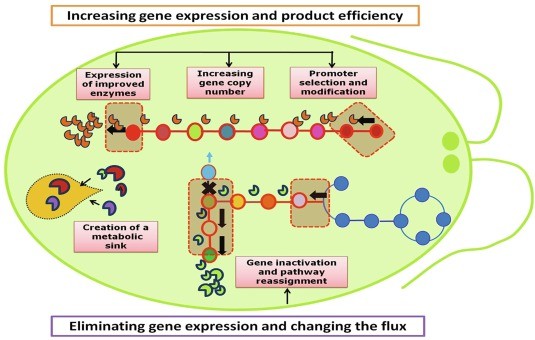The advent of the omics era has revolutionized the study of microalgal biology. Microalgae produce a large number of unique active secondary metabolites, and the application of metabolomic techniques in eukaryotic microalgae redesign pathways to increase algal metabolite production. Here, Lifeasible provides specialized solutions for microalgal metabolomics.
Metabolites are dynamic, and metabolomics is the integrated analysis of their properties and biosynthetic levels in the presence of different genetic and environmental changes. The secondary metabolism of microalgae is highly diverse because they have specific metabolic patterns closely related to the unique characteristics of their environment, such as light, stress, nutrients, salinity, and temperature. Changes in metabolic pathways absorbed from other species during evolution, such as through horizontal gene transfer, make it challenging to study the nature and function of microalgal metabolic pathways. However, many of the high-value products in eukaryotic algae are secondary metabolites, which increases the importance of revealing their molecular basis and opens the field for genetic improvement of these pathways of interest. Many bioactive metabolites (carotenoids, polyunsaturated fatty acids, polysaccharides, glycolipids) have been identified in various marine microalgae.
 Fig 1. Schematic representation of molecular engineering of algal cells for enhanced biosynthesis of metabolites. (Chakdar H, et al., 2021)
Fig 1. Schematic representation of molecular engineering of algal cells for enhanced biosynthesis of metabolites. (Chakdar H, et al., 2021)
Eukaryotic microalgae are a rich source of commercially essential metabolites, but their inherent genetic potential is often insufficient to support high production of target metabolites. We have worked to develop high-throughput analytical tools to collect microalgal metabolic engineering. Our scientists have successfully established phylogenetically and ecologically diverse model organisms of eukaryotic microalgae strains, freshwater Chlamydomonas reinhardtii, brackish-water Streptomyces, marine brown finger algae, and marine microalgae, to perform non-targeted metabolomic analysis of their exuded metabolites.
Here, Lifeasible provides custom microalgal metabolomics solutions for quantifying and identifying economically valuable secondary metabolites. In addition, we analyze the metabolite levels of microalgae under environmental stimuli or stressors. We develop customized processes for the analysis of microalgal metabolomics.
(1) Extraction of Microalgal Metabolites
We offer conventional extraction procedures (cells are quenched, and cellular metabolites are extracted with appropriate solvents), pressurized liquid extraction (PLE), and supercritical fluid extraction (SFE) to extract various metabolites from various microalgae.
(2) Microalgal Metabolite Analysis
We combine mass spectrometry with chromatographic techniques to identify and quantify different microalgal metabolites to identify the metabolic pathways that produce them, including amino acids, sugars, organic acids, and osmolytes.
(3) Targeted Microalgal Metabolism Analysis
Microalgal lipids are essential precursors for biofuels and nutrients. We offer specialized lipid, and fatty acid microalgal metabolic analysis.
(4) Redesigning Metabolic Pathways for Yield Enhancement
We establish stable (nuclear) transformation systems to provide metabolic engineering of microalgae, encoding the genetic information of target functions in specific metabolic pathways.
(5) Computational Modeling of Metabolic Pathways and Data Integration
We use genomics-derived information to construct genome-scale metabolic models of microalgae to map out metabolic processes associated with relevant genes and enzymes, enabling the prediction of microalgal metabolic responses under variable growth conditions.
At Lifeasible, our microalgal metabolomics services enable metabolite and metabolic pathway analysis for microalgae in studies related to biofuels, environmental management, adversity stress, and toxicology. We are your trusted partner in all aspects of microalgae research. If you are interested in our solutions for microalgal metabolomics, please do not hesitate to contact us.
Reference
Lifeasible has established a one-stop service platform for plants. In addition to obtaining customized solutions for plant genetic engineering, customers can also conduct follow-up analysis and research on plants through our analysis platform. The analytical services we provide include but are not limited to the following:
Get Latest Lifeasible News and Updates Directly to Your Inbox
Adaptive Evolutionary Mechanism of Plants
February 28, 2025
Unraveling Cotton Development: Insights from Multi-Omics Studies
February 27, 2025